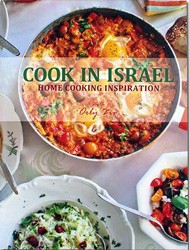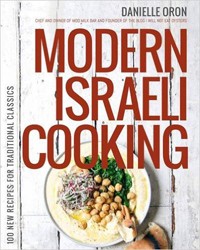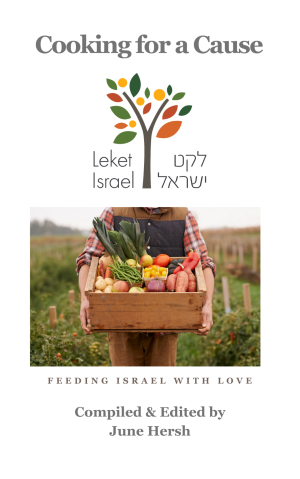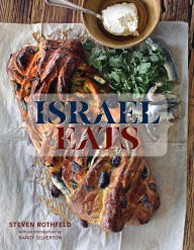With an unusual cushiony cover and gorgeous mouthwatering photos of meticulously detailed recipes, Jerusalem: A Cookbook features the recipes and stories of Yotam Ottolenghi and Sami Tamimi. The two chefs grew up in Jerusalem, Yotam in Jewish West Jerusalem, Sami in Muslim East Jerusalem.
Yotam owns an eponymous restaurant with four branches in London and a high-end restaurant called Nopi, also in London. Sami is his restaurant partner and head chef. Together, the two chefs have created a mostly-vegetarian cookbook that raises vegetables to an exquisite level, showcasing them beautifully in recipes that even a carnivore couldn’t resist.
The cookbook’s introduction explains the “complexities of Jerusalem’s culinary traditions,” where many dishes do not belong to one specific culture alone, but rather, in this city of an “intricate, convoluted mosaic of peoples,” to everyone. Chopped cucumber and tomato are known as either Arab or Israeli salad and are eaten throughout the city. Stuffed vegetables with rice and pickled vegetables are ubiquitous, as well as olive oil, lemon juice, and olives. Not to mention the recent “hummus wars,” in which Israelis and Arabs vie for who invented the dish and who makes it best.
The chefs recently spoke at the Strand Bookstore in Manhattan with Jonathan Safran Foer leading the discussion. Foer, a celebrated author and a vegetarian who wrote Eating Animals, began by assuring the audience that, while the recipes seemed difficult, they weren’t and joked about the unique ingredients called for in some of recipes. When Foer asked about their favorite meal, Yotam and Sami both expressed preferring homey rather than fancy food. To the question “what’s exciting you now?,” Sami immediately answered Tokyo, while Yotam said tapas bars in London, and ground cardamom was his “spice of the month.”
Foer spoke about culinary tourism, eating as a way of experiencing a culture or place. The chefs explained that some of their dishes are formed from Sami’s memory, recreated from his childhood impressions. He lost his mother when he was young so there’s nowhere else he could sample them today. He spends much of his time making sure each ingredient is used in the right amount, tweaking until it tastes as he remembers it.
Yotam said he never signs off on a recipe that’s good enough; it has to be marvelous and double tested. Their book was going to have 200 recipes — that was culled to 120 — and took two years to write. They are perfectionists who take their food seriously, making everything from scratch and using only natural ingredients.
The chefs also believe that food gives hope for peace and view food as ambassadors. Leaving the audience with an image of people rubbing shoulders in the market, they view food and as a vehicle toward a more harmonious future.
To create the story for their cookbook, Yotam and Sami used their personal memories and biographies, and, like most books about Israel, they said they couldn’t entirely avoid politics; by simply naming a recipe’s ingredients, or where to purchase them, it became political. While Foer says it’s “explicitly political but not provocative,” I agree, adding that some right-wingers may possibly be offended by the authors’ sentiments. (I offer this as a warning to know your recipient before gifting this book!)
Foer continued by asking the chefs about the perception of Middle Eastern food in world cuisine; there are no Michelin stars to date. Yotam’s feeling is that the cuisine hasn’t yet been properly explored and hopes the time has come for Middle Eastern food to get the respect it deserves.
When asked to define Israel food, Yotam explained that modern Israel is still a young society which started with Diasporan food, and has been changing over the last fifteen years. Ashkenaz food was considered “Jewish” food, while Sephardic food was “ethnic.” Sephardi food is quite complex, similar to Arab food. However, today in Israel the boundaries of these labels have begun to shift, as both Ashkenazi and Sephardic meals use the same fresh, local seasonal ingredients. Yotam said it’s too early to say where Israeli food is going; Israeli cuisine is still in formation.
Are they planning to open a restaurant in Jerusalem or New York? Yotam said he’s asked this often but, at the moment, he’s busy every single day at their restaurants in London. His priority is to create a sense of community, making it fun for his staff to come to work in their tiny kitchens, and creating a sense of family. He added that attention to detail and display is extremely important when cooking or presenting. “If the food doesn’t smile, we send it back.” From the comfortably flowing conversation I observed between the two charming chefs, I can easily imagine them running a harmonious kitchen.
Whatever you may think defines Jerusalem’s cuisine, you will surely be impressed by the array of recipes and photos of the people and food of the city. Whether it’s purchased as a coffee table book, a gift for yourself, or for a veggie-loving friend, this book is bound to please the lucky recipient. We can dream that the authors’ vision of food as an ambassador of peace could be true, with this cookbook a step along that noble path. Acknowledgments, index, introduction.
Recipe: Na’ama’s Fattoush
Ingredients
- scant 1 cup / 200 g Greek yogurt and ¾ cup plus 2 tbsp / 200 ml whole milk, or 1 2/3 cups / 400 ml buttermilk (replacing both yogurt and milk)
- 2 large stale Turkish flatbread or naan (9 oz / 250 g in total)
- 3 large tomatoes (13 oz / 380 g in total), cut into 2/3‑inch / 1.5cm dice
- 3 ½ oz / 100 g radishes, thinly sliced
- 3 Lebanese or mini cucumbers (9 oz / 250 g in total), peeled and chopped into −2÷3 inch / 1.5cm dice
- 2 green onions, thinly sliced
- 1/2 oz / 15 g fresh mint
- scant 1 oz / 25 g flat-leaf parsley, coarsely chopped
- 1 tbsp dried mint
- 2 cloves garlic, crushed
- 3 tbsp freshly squeezed lemon juice
- 1/4 cup / 60 ml olive oil, plus extra to drizzle
- 2 tbsp cider or white wine vinegar
- ¾ tsp freshly ground black pepper
- 1 1/2 tsp salt
- 1 tbsp sumac or more to taste, to garnish
If using yogurt and milk, start at least 3 hours and up to a day in advance by placing both in a bowl. Whisk well and leave in a cool place or in the fridge until bubbles form on the surface. What you get is a kind of homemade buttermilk, but less sour.
Tear the bread into bite-size pieces and place in a large mixing bowl. Add your fermented yogurt mixture or commercial buttermilk, followed by the rest of the ingredients, mix well, and leave for 10 minutes for all the flavors to combine.
Spoon the fattoush into serving bowls, drizzle with some olive oil, and garnish generously with sumac.
Reprinted with permission from Jerusalem: A Cookbook by Yotam Ottolenghi and Sami Tamimi, copyright © 2012. Published by Ten Speed Press, a division of Random House, Inc.Miriam Bradman Abrahams, mom, grandmom, avid reader, sometime writer, born in Havana, raised in Brooklyn, residing in Long Beach on Long Island. Longtime former One Region One Book chair and JBC liaison for Nassau Hadassah, currently presenting Incident at San Miguel with author AJ Sidransky who wrote the historical fiction based on her Cuban Jewish refugee family’s experiences during the revolution. Fluent in Spanish and Hebrew, certified hatha yoga instructor.





